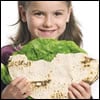What We Do
Break off two pieces from the bottom matzah. (You'll need one oz. of matzah altogether. Supplement with matzah from the box if needed.)
Now you know what the third matzah is for! If you’ve followed instructions until now, it should still be whole.
Take an olive-size volume of the bitter herb and place it in between those two pieces. Again, some mix together the horseradish and lettuce. Ask your bubbe (grandma) for your family custom.
Now you know what that second pile of bitter herb at the bottom of the seder plate is for.
Dip the bitter herb in the charoset. Shake off any excess.
Say the words: “This is what Hillel did, at the time that the Temple stood. He wrapped up some Pesach lamb, some matzah and some bitter herbs and ate them together.”
And you thought it was because they packed sandwiches to leave Egypt. Well, it is fast food.
Hillel read the words of the Torah about the Pesach lamb, “on matzah and bitter herbs you shall eat it,” and he took it literally. And so the sandwich was invented. Or maybe we should be calling it a hillel?
Lean to the left while you eat.
What It Means
In the view from within Egypt, this world is a mess of fragments. It’s called “The Passoverly Challenged Perspective.” Plain materialism. Where mitzvahs are a mishmash of dos and don’ts, Jews are a collection of irreconcilable riffraff, daily life is a cacophony of hassles and, well, just stuff.
Once we blast off far enough to escape materialism’s gravitational pull, we look back down and see a whole new perspective: It’s all a single landscape.
From up there looking down, mitzvahs are multiple expressions of a single spiritual path, Jews are multiple faces to a single soul, all the artifacts of today’s journey harmonize together as a symphony with a single conductor playing a single melody.
When we make ourselves into a temple for the Divine, the bitter, the sweet and the tasteless responsibilities of life wrap together in a single sandwich.








Start a Discussion